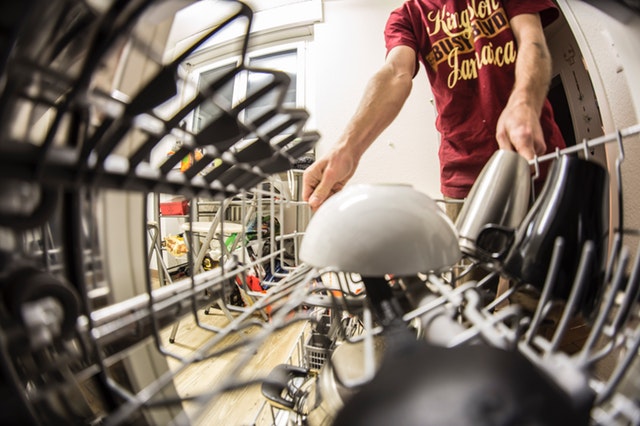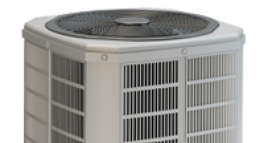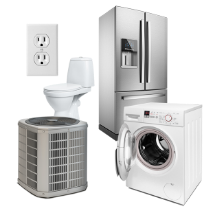If your dishwasher isn’t draining properly, it’s most likely a clog. But you might be able to fix it yourself. Here are a few simple things you can try to unclog your dishwasher. These tips might save you big professional bills while giving you the satisfaction of doing it yourself!
Run the Garbage Disposal for 30 Seconds
When your garbage disposal fills up or an air gap forms in one of the hoses, water can’t drain from the machine. Turn on your disposal while running water from the sink, and let it run for at least 30 seconds. Often, this step alone will clear up any blockage. If this doesn’t solve it, move on to Step 2.
Manually Drain the Dishwasher
If you notice standing water at the bottom of your dishwasher, place towels on the floor around it. Use a large cup or ladle to scoop as much of the water as possible into your sink or a large bowl. Use cloth or paper towels to soak up any remaining water when you get to the bottom.
Turn Off the Dishwasher’s Power
This step is essential, so please complete it before moving on to the next steps. Either unplug the dishwasher or switch off the circuit breaker first. This may require you to remove a fuse from a fuse box or flip a breaker on the circuit breaker panel to “Off” to disconnect the power.
NOTE: Some fuse boxes aren’t correctly labeled. To test whether you’ve turned the dishwasher’s power off, try running it after you remove a fuse or switch off a breaker.
Clear the Drain Basket
The drain basket usually sits on the bottom or side of the dishwasher’s interior. Check to make sure it’s not clogged with food or detergent. If it is, remove it and wash it under the sink until it’s clear, then replace it.
If you can’t find or remove the drain basket, pour a solution of 1 tablespoon of baking soda then 2 tablespoons of vinegar down the dishwasher drain (under the bottom rack). Let it sit for 15 minutes. Then, run hot water down the drain to clear the source of the clog.
Clear Blockages From the Bottom of the Dishwasher
Sometimes, food particles congeal under the dish racks at the bottom of the dishwasher. Check the bottom of the dishwasher, where water drains, and clear any blockage.
Check the Filter
Did you know that you should clean your dishwasher filter every 6 months to 1 year? If you haven’t cleaned it in a while, your filter could be the clog culprit.
Refer to your owner’s manual to find your appliance’s filter. Usually, it’s on the bottom of the dishwasher under the rack. Some dishwashers have an upper and lower filter assembly. If yours does, disassemble the parts and run water over the filter assemblies. Do not use wire brushes or scouring pads, as they can damage your filter. Use a soft-bristled brush (e.g., an old toothbrush) and soap to remove calcium deposits and debris. Then, re-install the filter.
Check the Drain Hose
Older drain hoses can form kinks, which can create clogs. Refer to the owner’s manual to locate the drain hose. Then, inspect the hose to make sure there are no kinks or clogs. Straighten out any kinks you encounter. For clogs, carefully insert a straightened wire hanger into the hose to remove any debris. Finally, make sure you securely connect the seal of the hose at both ends if it’s come loose.
Check Your Drain Valve
Consult your owner’s manual to locate the drain valve, which is usually at the bottom of the dishwasher. You should be able to move the drain valve easily with your fingers. If the valve doesn’t move freely when you push on it, its electrical components may have burned out.
If so, you may need to replace it, likely by researching, vetting, finding and scheduling an appointment with a professional. If you have a systems and appliances warranty with 2-10 Home Buyers Warranty (2-10), you can simply report a claim, and we’ll dispatch a quality, approved service contractor to assess it.
Check the Air Gap
If you have an air gap, you may need to check it (it’s a small, egg-shaped protrusion near your faucet). When the air gap gets clogged, it can prevent your dishwasher’s draining process. If you notice water flooding onto your counter from the air gap, this is most likely the cause.
Clear the air gap by simply taking off the cap and cleaning it out with a bottle or pipe brush. You can also flush it with a funnel and hot water.
Listen to Your Dishwasher
Once you’ve tried the above steps to fix the problem, run your dishwasher and listen. If it’s making noises it doesn’t typically make, especially if it’s a humming or clicking noise, you may need to replace your drain pump and motor. This will likely require a professional. With a 2-10 systems and appliances home warranty, you can quickly file a claim and have a quality, approved professional begin to solve the problem at a cost much lower than repairing or replacing it yourself.









